buildings of Alexander Severus
1998.09.21
The building projects of Alexander Severus as described within the The Scriptores Historiae Augustae.
...the Porticus Alexexandri Severi is in a totally incorrect position at the end of the Equiria, however, Piranesi may be making a suggestive link between Alexander Severus and the military. The small aedicule Isidis on the Equiria across from the Porticus may also be a reference to Alexander's devotion to his mother--Isis is the premiere mother goddess.
...the baths, aqueduct and his grove all comply correctly within the Ichnographia.
...the Domus (Palace of ) Alexandri Severi is mentioned in the Historiae text, but it is not described, and my theory is that Piranesi placed Alexander's (house) Palace along the Triumphal Way (in the reverse mode) because he favored Christianity and the Golden Rule. The Domus Alexandri Severi is also exactly like the description of Elagabalus' Palace near the Porta Maggiore. Could Piranesi be weaving some complicated message which refers to both the reigns of Elagabalus and Alexander (which did follow each other, and they were cousins), where Alexander successfully undid the corruption of Elagabalus and began to turn Rome toward a more Christian and morally sound city and empire?
...not yet sure, but I think Alexander Severus' name is attached to more buildings within the Ichnographia second only to Nero.
Circulus
Ludus
1998.12.01
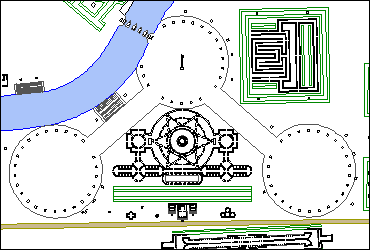
Fasolo, a mid-twentieth century art historian, criticized the Circulus and Officinae Armorum complex as "a triangular and star-shaped system to which it is certainly not possible to find a comparison in classical typology." Although Fasolo's observation is correct, it is nonetheless unfortunate that he did not recognize the overriding "Martian honor" theme of Piranesi's Equiria design. Furthermore, Fasolo failed to detect the pattern of inversion Piranesi employs throughout the Ichnographia, particularly with regard to the large plan's archeological and historical inconsistencies, and, in this case, the circular and triangular formation of Piranesi's parade grounds may well represent an inverted delineation of ancient Rome's real military grounds, the huge square shaped Praetorian Camp, which was in an altogether different section of the city.
Equiria
1998.12.01
The Equiria's delineation within the Ichnographia Campus Martius represents the path that the horse-races took. Although Piranesi's linear positioning of the race course maintains some veracity, this rendition of the Equiria, along with its surrounding buildings, exhibits Piranesi's own design rather than an accurate display of the ancient Roman topography within this respective region. For example, the line of the Ichnographia's Equiria coincides exactly with Rome's present-day Via Flaminia, and the Via Flaminia, in turn, is a northern extension of the Corso, which is the traditional site of the races, and derives its name from the same equorum cursus as the Equiria. Like the present Via Flaminia, Piranesi's Equiria is a northern extension of the ancient horse-race's actual place of occurrence. Furthermore, Piranesi starts his Equiria just north of the Petronia Amnis, but Piranesi moved this ancient stream to a more nothern position as well. Hence, Piranesi is obviously aware of the historical facts, yet he chose to transfer the facts to another location. Moreover, Piranesi's careful programming and designing of the buildings either side of his Equiria supports the supposition that he deliberately moved the Equiria to a more accommodating and serviceable location. Piranesi's actions in this regard are thus willful in both senses of the word -- he did not comply with historical accuracy, although he drew the Equiria with the best redesign intentions.
Petronia Amnis
1998.12.01
Although the Petronia Amnis did exist in ancient Rome, Piranesi dislocates the stream to a far more northern position. According to Platner, "there were several swamps or ponds in this low-lying district [the Campus Martius], as well as streams, the largest of which, the Petronia amnis, came from a spring on the Quirinal, called Cati fons, and flowed into the largest swamp, the palus Caprea, or Capreae, where were afterward the pool and baths of Agrippa."¹ There is no real satisfactory explanation why Piranesi chose to move the Petronia Amnis further north of its archeologically correct position, however, the dislocation fits within the same pattern whereby Piranesi moved the Equiria to a more northern position as well. It is as if Piranesi purposefully exaggerated the scope of the Campus Martius in order to present a more availing "reenactment" of Rome's past.
1. Samuel Ball Platner, The Topography and Monuments of Ancient Rome (Boston: Allyn and Bacon, 1904), p 322.
Porticus
1998.12.01
The porticus is the most prevalent building typology within the Ichnographia Campus Martius. At least one porticus is found within every quadrant of the large plan, and cumulatively they add up as the most numerous building type within the Campus Martius, a portrayal which is both historically and archeologically sound. That is not to say, however, that each porticus Piranesi delineates has a historical basis. For example, the two Porticus Hadriani, the Porticus Horti Domitiae, at least one of the Porticus Neronianae, the Porticus praebentes umbraculum diei ab aesti, the Porticus Quirini, and the Porticus Trajani have no relationship with historical fact. Furthermore, many of those porticus that hold factual veracity, Piranesi dislocates within the large plan, and, overall, none of the porticus within the Ichnographia, with the exception of the Porticus Septorum Juliorum, express historically correct designs.
Porticus Alexandri Severi
1998.12.01
The Porticus Alexandri Severi, like the Porticus Vipsania and the Naumachia Domitiani, is one of the buildings along the Ichnographia's Equiria that represents an actual ancient Roman building, however Piranesi situates the Porticus Alexandri Severi much further north than its true historical location. According to Lampridius, "Alexander also began the Basilica Alexandrina, situated between the Campus Martius and the Saepta of Agrippa, one hundred feet broad and one thousand long and so constructed that its weight rested wholly on columns; its completion, however, was prevented by his death." This ancient account places the real "Porticus Alexandri Severi" within the immediate area of the Pantheon, a location far south of Piranesi's positioning of the porticus at the northern end of the Equiria. Piranesi's design and dislocation of the Porticus Alexandri Severi bears a firm symbolic significance within the overall scheme of the Ichnographia Campi Martii, however.
Porticus Vipsania
1998.12.01
The Porticus Vipsania, like the Porticus Alexandri Severi and the Naumachia Domitiani, is one of the buildings along the Ichnographia's Equiria that represents an actual ancient Roman building, however Piranesi situates the Porticus Vipsania further north than its true historical location. The real Porticus Vipsania was within the Campus Agrippae along the Via Lati, close to the Pantheon, and not within the northern region beyond the Aurelian Wall as Piranesi shows it. For modern archeologists, the Porticus Vipsania is interchangeable with the Porticus Polae, and, adding further to the confusion, Piranesi delineates a separate Porticus Polae directly in front of the Pantheon. Needless to say, the inaccuracy of Piranesi's portrayal of the Porticus Vipsania is just one example of why the Ichnographia was never taken seriously as an valid archeological reconstruction.
Piranesi: inter-disciplinarian
1998.12.20
...Piranesi employing both archeological skills and architectural/urban design skills to engrave the Ichnographia.
mistakes
1999.05.17
| |
one more Piranesian daze: circus act
2000.05.15
In attempting to discern the possible reason or message manifested by the plan changes to the Circus of Caligula and Nero and to the Circus Agonalia, I began to think of these specific circuses and how they may or may not relate to the numerous other circuses delineated throughout the Ichnographia. Within the version of the Ichnographia that is presently widely published there are six circuses, the Circus Caji et Neronis, the Circus Agonalia, the Circus Hadriani, the Circus Domtiae, the Circus Flaminius, and the Circus Apollinaris. With only minor adjustments to length, each circus is delineated in a virtually identical fashion, and, moreover, each circus reflects an archaeologically correct circus plan. As already illustrated, the plans of the Circus Caji et Neronis and the Circus Agonalia within the University of Pennsylvania Ichnographia reflect more stylized, i.e., archaeologically incorrect, circus formations. Since all the circuses are identical in the widely published version of the Ichnographia, I then began to wonder, via transposition, whether all the circuses within the Penn Ichnographia were likewise identical there in the form of exhibiting plan changes. In all honestly, I had not noticed any plan changes to the circuses other than the Circus Caji et Neronis and the Circus Agonalia the two times I had seen the Penn Ichnographia prior, but nor did I have any pictorial hardcopy evidence that there are no other plan changes. Having worked with the Ichnographia for over ten years, if I have learned anything, it is that the Ichnographia, no matter how well you think you know it, continually maintains the uncanny ability to beguile. Therefore, it was necessary for me to once more return to the other Ichnographia.
Upon doing further research, i.e., going back to the University of Pennsylvania's Fine Arts Library to again scan the Ichnographia Campus Martius, more plan changes were indeed discovered, and, just as I had begun to suspect, the "change of plans" effected the Circus Hadriani, the Circus Domitiae, the Circus Flaminius, and the Circus Apollinaris. Thus, it is now evident that each of the major "changes of plan", between the Ichnographia Campus Martius that is widely published and the Ichnographia Campus Martius within the rare book collection at the University of Pennsylvania's Fine Arts Library, occur more or less exclusively within those buildings of the Ichnographia labeled "circus".
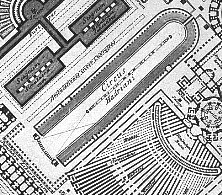 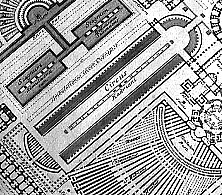
The plan above left is the Circus Hadriani as it appears within the commonly reproduced Ichnographia. Above right is the Circus Hardiani as it appears within the Ichnographia at the University of Pennsylvania.
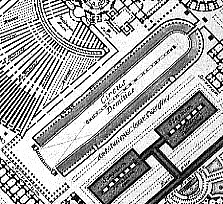 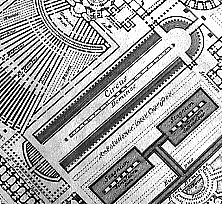
The plan above left is the Circus Domitiae as it appears within the commonly reproduced Ichnographia. Above right is the Circus Domitiae as it appears within the Ichnographia at the University of Pennsylvania.
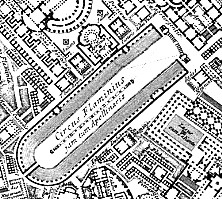 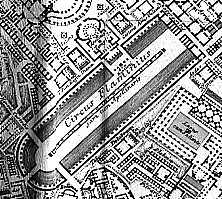
The plan above left is the Circus Flaminius as it appears within the commonly reproduced Ichnographia. Above right is the Circus Flaminius as it appears within the Ichnographia at the University of Pennsylvania.
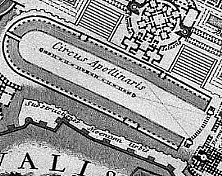 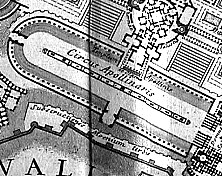
The plan above left is the Circus Apollinaris as it appears within the commonly reproduced Ichnographia. Above right is the Circus Apollinaris as it appears within the Ichnographia at the University of Pennsylvania.
As the above plan comparisons indicate, the newly discovered circus plans engage directly with their neighboring buildings, thereby rendering a connected contextualism and demonstrating a more integrated urban planning methodology. The circus plans of the commonly reproduced Ichnographia on the other hand, albeit archaeologically correct, do not engage their immediate surroundings, and appear as though literally afterthoughts. Beside the already mentioned questions as to what these changes might mean and which set of plans came first, or what Piranesi's intentions in making the changes might have been, there is now an additional question as to why the changes were specifically and only applied to the Campo Marzio's six circuses.
another Piranesian daze
2000.05.16
...went back to again scan the Ichnographia Campus Martius, and just as I'd begun to suspect, all the circuses within the Ichnographia show a change of plan. ...the circuses of the Ichnographia in its common version are more archeologically correct.) ...the circuses of Hadrian and Domitiae as represented in the frontispiece comply with the "uncommon" circus plans...
Re: Favorite Artist?
2003.01.24 15:27
I favor Piranesi because he treated historiography as art, the same way he treated archaeology as art. What he did came right before the distinct rise of science, and it's separation from 'art'.
...and speaking of random tangents
2007.03.12 17:05
"In a sense Asimov, Heinlein, and the masters of American Science Fiction are not really writing of science at all . . . They're writing a kind of fantasy fiction about the future, closer to the Western and the Thriller, but it has nothing really to do with science . . . Freud pointed out that you have to distinguish between analytic activity. which by and large is what the sciences are, and synthetic activities which are what the arts are. The trouble with the Heinlein-Asimov type of Science Fiction is that it's completely synthetic. Freud also said that synthetic activities are a sign of immaturity, and I think that's where classical Science Fiction falls down."
--Ballard, Speculation, 1969.
Upon first reading this passage, thoughts of how Piranesi's Il Campo Marzio dell'Antica Roma and particularly the Ichnographia Campi Martii have been largely misinterpreted by 20th century architectural 'scholarship' came to mind. The synthetic quality of Piranesi's archaeology (before archaeology was formalized into a science) is all the critics/theoreticians saw, and they completely discounted the analytical aspect of Piranesi's archaeology. Basically, a non-analytical analysis resulted in a synthetic interpretation.
The wonderful thing about Il Campo Marzio dell'Antica Roma (including the Ichnographia Campus Martius) is that the distinction between the analytical and the synthetic is never manifest--the work seamlessly embodies both natures.
|